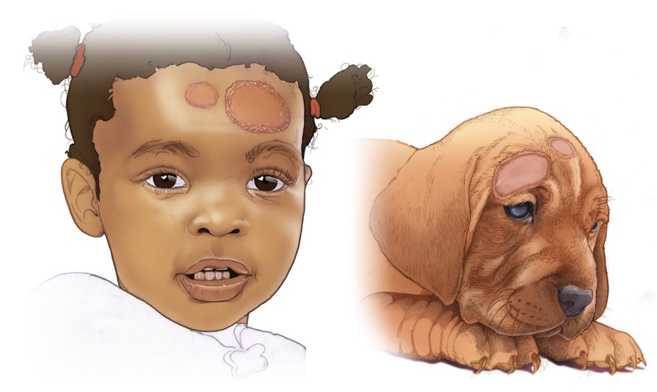Ringworm
(Dermatophytosis Infection)

Girl next to dog. Both have red round patches on their skin.
Ringworm is a skin and scalp disease caused by fungi. It gets its name from the characteristic ring-like rash on the skin. The disease is spread by touching an infected person or animal. It can also be spread by touching objects or surfaces that had contact with the infection. If infected, people often begin itching four to fourteen days after contact. The rash may be scaly, reddened, and circular. Ringworm on the scalp usually makes a bald patch of scaly skin.
How animals and people become infected
Animals, like people, get infected through touching an infected animal's skin or hair or by touching things that are infected with the fungus, like blankets and towels.
Many different kinds of animals can transmit ringworm to people. Dogs and cats, especially kittens or puppies, can have ringworm that can be passed to people. Cows, goats, pigs, and horses can also pass ringworm to people.
Ringworm appearance in pets
Dogs and cats
Adult animals, especially long-haired cats, do not always show signs of ringworm infection. Puppies and kittens most often have patches that are hairless, circular, or irregularly shaped areas of scaling, crusting, and redness that may or may not be itchy. The area may not be completely hairless, and instead have brittle, broken hairs. If the claws are affected, they may have a whitish, opaque appearance with shredding of the claw's surface. If you suspect your pet has ringworm, make sure it is seen by a veterinarian.
Lambs
Ringworm is also fairly common in show lambs, and is referred to as "club lamb fungus." Lambs usually have circular, hairless areas with thick scabs on their head and face.
People
Do:

Vacuuming areas of the home that pets commonly visit helps to remove fur or flakes of skin.
- Wash your hands with soap and running water after playing with or petting your pet.
- Wear gloves and long sleeves if you must handle animals with ringworm, and always wash your hands after handling the animal.
- Vacuum the areas of the home that the infected pet commonly visits. This will help to remove infected fur or flakes of skin.
- Disinfect areas the pet has spent time in, including surfaces and bedding.
- The spores of this fungus can be killed with common disinfectants like chlorine bleach diluted 1:10 (1/4 cup in 1 gallon of water), benzalkonium chloride, or strong detergents.
- Never mix cleaning products. This may cause harmful gases.
Do not handle animals with ringworm if your immune system is weak in any way (if you have HIV/AIDS, are undergoing cancer treatment, or are taking medications that suppress the immune system, for example).
Pets
Protect your pet's health
- If you suspect that your pet has ringworm, make sure it is seen by a veterinarian so treatment can be started.
- If one of your pets has ringworm, make sure you have every pet in the household checked for ringworm infection.
People
Your doctor may test skin scrapings or nail clippings for the fungus. Ask your doctor about proper treatment for ringworm. Some infections can get better if you
- Keep your skin clean and dry
- Apply drying powders, lotions, or creams
- Wash your bed sheets and clothes every day while you are infected
In some cases you may need to use antifungal ointments or creams, or take antifungal pills that your doctor may prescribe.
Pets
Your veterinarian may test some fur for the fungus. Treating animals for ringworm can help them clear the infection sooner and prevent spreading the infection to other people and animals. Your veterinarian may prescribe antifungal shampoos or creams, dips, or antifungal pills. During this time, the pet should be handled as little as possible until the infection is cleared.
On the web
Dermatophytes including ringworm
CDC site
National Institute of Health: Ringworm
Medline Plus
Club Lamb Fungus [PDF – 1 page]
California Department of Food and Agriculture
Compendium of measures to prevent disease associated with animals in public settings. Morbidity and Mortality Weekly Report. 2011;60(RR04):1-24.
Dermatophytosis [PDF – 13 pages].
Center for Food Security and Public Health.
Other publications
Riley PY, Chomel BB. Hedgehog zoonoses [PDF – 5 pages]. Emerging Infectious Diseases. 2005 Jan; 11(1):1-5.
Merchant SR. Dermatophytosis. In: Aiello SE, Mays A, editors. The Merck veterinary manual. 8th ed. Whitehouse Station, NJ: Merck and Co; 1998. p. 626-629; 1419.
Hopkins FM, Gill W. Ringworm (club lamb fungus) in sheep [PDF – 4 pages]. University of Tennessee Agriculture Extension Service.
- Page last reviewed: April 30, 2014
- Page last updated: April 30, 2014
- Content source:


 ShareCompartir
ShareCompartir